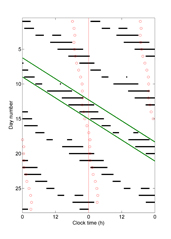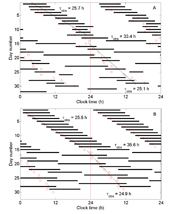Overview

To validate the model, we are simulating human sleep/wake patterns during forced desynchrony protocols, in which the day length is not 24 hours. This raster plot shows sleep periods (dark bars) on a 28-hour-day protocol, with a restricted 9.3-hour time during which sleep is allowed (indicated by the green bars). Consistent with data, the model predicts better sleep when sleep periods are aligned near the circadian minimum (red circles). Image courtesy of Andrew J.K. Phillips, Ph.D. Click here for larger image.
Physiologically-Based Modeling of Sleep-Wake Scheduling and the Effects of Pharmaceuticals (Postdoctoral Fellowship)

The combined model is able to reproduce spontaneous desynchrony of circadian and sleep/wake cycles during self-selected schedules. Raster plots are shown for (A) data and (B) model, with black bars indicating sleep periods, and red circles showing times of minimum core body temperature. Image courtesy of Andrew J.K. Phillips, Ph.D. Click here for larger image.
Principal Investigator:
Andrew J.K. Phillips, Ph.D.
Organization:
Brigham and Women's Hospital
Spaceflight requires astronauts and support personnel on the ground to be mentally sharp at all times. Sleep loss and long and inconsistent work schedules can pose serious risks to safety and mission success. It is important that countermeasures are developed to reduce risks.
Dr. Andrew Phillips’ project seeks to develop a comprehensive model to predict performance and alertness during many different conditions. Phillips has combined two existing models of the sleep-wake switch and circadian systems, so as to yield improved predictions of performance, and new diagnostics for assessing schedule suitability on an individual basis. This will allow for improved assessment and design of mission schedules. The new model is also being extended to predict the efficacy of drugs such as caffeine, modafinil and melatonin as countermeasures for reducing fatigue and combating insomnia.
In addition to use by astronauts and ground-support personnel, the model has a wide range of applications on Earth. It could be used in optimizing shift work and other work schedules and for better understanding and regulating pharmaceuticals use in treating sleep disorders.
NASA Taskbook Entry
Technical Summary
NASA astronauts and ground crew must meet high-level cognitive and physical demands around-the-clock. These tasks place extreme stress on human physiology, which evolved under conditions of 24-hour days with ample rest. The effects of sleep loss, circadian misalignment and extended schedules on performance and subjective alertness pose serious risks to mission success. It is therefore crucial that countermeasures are developed for optimizing schedules and guiding pharmaceutical use.
Mathematical modeling provides a means of predicting performance and alertness under many different, including untested, conditions. Improved knowledge of sleep physiology has enabled development of more sophisticated models of sleep and wake. A physiologically-based model of the sleep-wake switch has been developed and applied to sleep deprivation, shift work, pharmacologic stimuli and fatigue. Meanwhile, a circadian model developed at the Brigham and Women's Hospital (BWH) has been applied to predicting performance and alertness, designing pre-mission countermeasures and optimizing mission scheduling.
The original aims were to combine the sleep-wake switch and circadian models, and incorporate pharmaceutical effects. We have successfully combined the sleep-wake switch and circadian models, including physiological interactions between these systems, thereby developing the most comprehensive model of human sleep/wake dynamics to date. This model has since been used to understand the physiological mechanisms underlying inter-individual differences in chronotype (i.e., morningness/eveningness preference) and spontaneous desynchrony of the endogenous circadian rhythm from sleep/wake patterns during self-selected schedules. It has also been tested against data collected at the BWH research facilities during forced desynchrony experiments in which sleep/wake schedules are desynchronized from endogenous circadian rhythms using a non-24-hour sleep/wake cycle.
Results show that the model is capable of predicting the sleep/wake patterns observed during this imposed schedule, including difficulty initiating and maintaining sleep when scheduled at inappropriate circadian phases. Currently, the model is also being extended to include pharmaceutical effects, and we have already set the groundwork for incorporating the effects of caffeine, melatonin and modafinil. Recently, we showed that the model can be used to predict the effects of exogenous doses of melatonin on melatonin concentration in the blood and phase shifts of the circadian pacemaker. We are now also incorporating data for caffeine from experiments conducted at BWH. Further development of the model will result in improved estimates of performance measures, and new diagnostics for assessing schedule suitability on an individual basis, including chronotype.
With much of the basic science now complete, we aim to develop a predictive software tool for optimizing the timing and use of pharmaceutical countermeasures for extended wake durations and circadian misalignment conditions. This tool will be usable by a non-specialist, and will allow the user to compare the efficacy of a user-inputted alternative countermeasure timing to the optimized solution so as to be flexible to the realities of schedule design. This tool will allow the findings to be deployed to the operational environment.
This research program will not only significantly reduce risks on future NASA missions, but also has broad applications to optimizing shift work and other work schedules on Earth. The tool we develop will be easily generalizable to managing extended wake and circadian misalignment conditions in industries such as defense, healthcare, transport, and shift workers. Furthermore, the researchers anticipate that their research will lead to better understanding and regulation of pharmaceuticals for use in treating sleep disorders.
Earth Applications
Risks associated with fatigue due to circadian misalignment or extended wake are a serious danger in many work environments. Specifically, industries such as transportation, aviation, health care and defense often demand long and irregular working hours, with performance failures resulting in potentially fatal consequences. Developing effective countermeasures for fatigue is thus a problem with broad applicability on Earth.
This NSBRI research project addresses the issue of fatigue through the development of a mathematical model of human sleep and circadian rhythms that is also able to incorporate pharmaceutical effects. This approach provides three separate means of managing and reducing risks associated with fatigue: (1) The model can be used to guide the development of safe schedules; (2) The model can be used to predict times when fatigue-related risks will be greatest; snf, (3) The model can be used to optimize the use and timing of fatigue countermeasures, including light, naps and pharmaceuticals.
Shift work and circadian disruption have been identified as significant risk factors for cancer, cardiovascular disease, diabetes, and suppressed immune function. The need for mathematical tools to circumvent - or at least minimize - occupational risks is thus a growing requirement, given the large proportion of the U.S. population involved in shift work. Providing a framework for better understanding and predicting the effects of pharmaceuticals that interact with the circadian and sleep/wake systems is also of wide importance. With the explosion in use of over-the-counter products such as caffeine and melatonin, it is important to develop models that can aid in understanding the physiological and performance impacts of self-medication. Furthermore, since the model is physiologically based, it could be used to help identify target pathways for future pharmaceuticals, and to better understand drugs of known efficacy but unknown mode of action (e.g., modafinil).
Developing mathematical models of sleep/wake and circadian rhythms is also a problem of basic scientific value. Such models serve multiple roles, including: (1) Improving our understanding of how the underlying physiology gives rise to the observed dynamics; (2) Making predictions about how the system will respond under untested conditions; and (3) Aiding the design of experimental protocols by predicting which conditions will provide the most informative results, thus making better use of available resources. The two-way dialogue between experimentalists and theorists is proving to be highly valuable to the sleep/wake and circadian scientific communities. New experimental findings inform the design and refinement of mathematical models, while models provide insight into the observed phenomena. In our case, the unexpected finding that our model can reproduce the sleep of other species is an excellent example of how modeling provides us with the tools to expand our scientific horizons. ~Earth-based Applications of Research Project
Risks associated with fatigue due to circadian misalignment or extended wake are a serious danger in many work environments. Specifically, industries such as transportation, aviation, health care and defense often demand long and irregular working hours, with performance failures resulting in potentially fatal consequences. Developing effective countermeasures for fatigue is thus a problem with broad applicability on Earth.
This NSBRI research project addresses the issue of fatigue through the development of a mathematical model of human sleep and circadian rhythms that is also able to incorporate pharmaceutical effects. This approach provides three separate means of managing and reducing risks associated with fatigue: (1) The model can be used to guide the development of safe schedules; (2) The model can be used to predict times when fatigue-related risks will be greatest; snf, (3) The model can be used to optimize the use and timing of fatigue countermeasures, including light, naps and pharmaceuticals.
Shift work and circadian disruption have been identified as significant risk factors for cancer, cardiovascular disease, diabetes, and suppressed immune function. The need for mathematical tools to circumvent - or at least minimize - occupational risks is thus a growing requirement, given the large proportion of the U.S. population involved in shift work. Providing a framework for better understanding and predicting the effects of pharmaceuticals that interact with the circadian and sleep/wake systems is also of wide importance. With the explosion in use of over-the-counter products such as caffeine and melatonin, it is important to develop models that can aid in understanding the physiological and performance impacts of self-medication. Furthermore, since the model is physiologically based, it could be used to help identify target pathways for future pharmaceuticals, and to better understand drugs of known efficacy but unknown mode of action (e.g., modafinil).
Developing mathematical models of sleep/wake and circadian rhythms is also a problem of basic scientific value. Such models serve multiple roles, including: (1) Improving our understanding of how the underlying physiology gives rise to the observed dynamics; (2) Making predictions about how the system will respond under untested conditions; and (3) Aiding the design of experimental protocols by predicting which conditions will provide the most informative results, thus making better use of available resources. The two-way dialogue between experimentalists and theorists is proving to be highly valuable to the sleep/wake and circadian scientific communities. New experimental findings inform the design and refinement of mathematical models, while models provide insight into the observed phenomena. In our case, the unexpected finding that our model can reproduce the sleep of other species is an excellent example of how modeling provides us with the tools to expand our scientific horizons.
This project's funding ended in 2012







